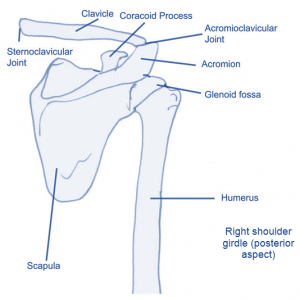The shoulder girdle and shoulder joint
The shoulder (or pectoral) girdle forms the basis of attachment of the upper limb to the trunk and provides attachment points for many muscles that move the arm. Each consist of a clavicle (collar bone), which articulates (joins) with the sternum (breastbone) at the front, and with the scapula (shoulder blade) behind.
The pectoral girdle does not form a complete bony ring, as the scapulae do not articulate with the vertebral column. They are attached to the back of the ribcage by a complex arrangement of muscles.
This arrangement of bony and muscular girdle increases the mobility of the shoulder girdle and allows the upper limbs to move in any direction through a large range. This is because only the clavicles attach to the axial skeleton, allowing the scapulae to move quite freely across the thorax and hence the arm with it; and because the socket of the shoulder joint (the scapula’s glenoid fossa) is shallow and poorly reinforced with ligaments, so as not to restrict the movement of the humerus.
This arrangement, although good for mobility, is bad for stability – and shoulder dislocations are relatively common. The humerus fits into the shallow glenoid cavity/fossa of the scapula in a manner that allows the arms to hang freely at the sides of the body.
On the posterior (rear) side of the scapula, there is a prominent ridge called the acromion (which forms the ‘point of the shoulder’). The acromion joins with the clavicle (acromio-clavicular joint) forming a gliding synovial joint. The clavicle, in turn, joins onto the sternum at the sterno-clavicular joint – this is where the shoulder girdle joins onto the axial skeleton.
The glenohumeral (shoulder) joint is very shallow, making the head of the humerus potentially unstable. Too many ligaments would restrict movement in what needs to be a highly mobile joint. The rotator cuff muscles (supraspinatus, subscapularis, infraspinatus and tere minor) help to hold the humerus in the glenoid cavity during movement.
Unfortunately, because of their prime role in shoulder stabilisation, the rotator cuff muscles suffer significant wear and tear, particularly from rubbing and compression of their tendons on the bony parts of the shoulder joint. This is called impingement. Any movement of the shoulder joint, but especially overhead activities involving rotational movement, should be performed with control.
For example, performing the lat pull-down behind the neck using fixed resistance machines. This move involves a starting position of full abduction, extension and lateral rotation of the humerus with an elevated and retracted shoulder girdle. Lateral rotation, retraction and extension then needs to be maintained throughout adduction and depression of the shoulder girdle and the return to the starting position against resistance.
Almost all of the muscles of the shoulder girdle and shoulder joint are involved, requiring considerable body awareness, coordination, control and technical capability to avoid impingement.
By adopting a starting position where the bar is lower, flexing at the shoulder and holding the bar with a narrow supinated grip, pulling the bar to the front instead of the back of the body (removing lateral rotation, extension, scapular retraction and shoulder girdle elevation) dramatically decreases the risk of injury while still effectively targeting the intended muscle.
Many actions that risk impingement, however, are difficult to control – such as overhead throwing. This makes it all the more important to apply control wherever possible.

